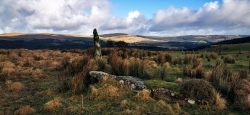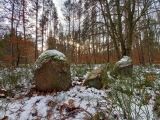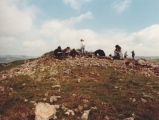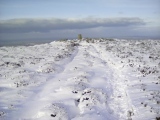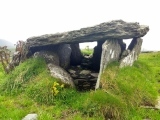Andy Burnham's Blog, page 180
January 22, 2021
Dulnain Bridge
About 18000 years ago, Dulnain Bridge, a village in Strathspey, Highlands was covered by a vast ice sheet up to 700m deep and moving east. On the eastern edge of the village there are some unusually shaped rocks known as Roches Moutonnees. These have been shaped by the passage of the glacier - the characteristic smooth shallow slope in the direction of the glacier's advance, with a steep edge in the lee of the glacier.
Published on January 22, 2021 05:03
January 20, 2021
Knocknagappul Stone Row
A stone row in county Cork with three stones. One of the stones is standing, and two are prostrate.
This panorama is looking North East with the Boggeragh Mountain range in the background, the third stone lies in the foreground, it is 4 metres long amazingly.
This panorama is looking North East with the Boggeragh Mountain range in the background, the third stone lies in the foreground, it is 4 metres long amazingly.
Published on January 20, 2021 14:43
January 19, 2021
Bärens Kirchhof
This iron age stone circle in Brandenburg consists of about 15 small stones, the largest is approx. 70 cm tall, others protrude only a few cm from the ground. The place has the name because of an old legend meaning that it is the cemetery / churchyard (Kirchhof) of someone named Bärens who, according to the legend, died there.
Published on January 19, 2021 09:29
January 18, 2021
Rejnstrup Langdysse 3
New photos from Tonnox on our page as well as this lovely engraving by A.P. Madsen, 1868. A magnificent langdysse (Chambered long Barrow) in Sorø. 2.5 x 60 x 11 m. A Rectangular curbstone chain. No mound, but the area within the curbs is filled with several layers of stone up to 1m long. East of the centre there is a chamber consisting of 4 supporting stones and 1 cover stone.
Published on January 18, 2021 10:50
Peatshiel Sike
A standing stone in Dumfries and Galloway, on the SW slope of Bodesbeck Law, approximately 5 miles NE of Moffat. Viewed from the SW, the stone mimics the summit profile of Bodesbeck Law behind it. I found two possible standing stones recumbent in the vicinity of Peatshiel Sike, so it may have been part of a stone alignment or setting.
Published on January 18, 2021 10:41
January 14, 2021
Wigber Low
Archive photos from the Wigber Low excavation in 1990 by Sheffield University, visit Orcinus' page for more . Round Barrow in Derbyshire. Look around you and take in the spread of stones across the ground this is an area with distinct historical significance. The clues are in the name of this site: Wigber most likely originates from the Anglo-Saxon name of Wigca and Low meant small hill or burial ground. The barrow was first built between 3,000 to 4,000 years ago, but several Anglo-Saxon graves from between 500 to 600 CE were later inserted into the mound.
Published on January 14, 2021 08:53
Gurness
The Brock of Gurness at midsummer dawn, more amazing photos on our page. The Broch of Gurness is an imposing fort on the north shore of Mainland Orkney. Of classic drystone construction the Iron Age round tower fort is flanked by a number of ancillary structures and impressive concentric ditch and rampart outer defenses; moreover, the rocky shoreline cliffs posed an formidable approach for marine invaders.
Published on January 14, 2021 05:09
January 12, 2021
Grafheuvels op de Zuilensteinse Kop (45579)
A collection of Round Barrows near Utrecht. In 1982 the barrows were restored and an information board was placed at the site. See our nearby sites list for more barrows close by.
Published on January 12, 2021 07:06
January 11, 2021
Carnedd Moel Y Ci
Snow!. Round Cairn in Gwynedd. Situated on the leading lower edge of the NW summit of Moel Y Ci, the cairn is easily accessed via well established footpaths. Moel Y Ci is an enclosed moorland environment. The cairn is circular with a diameter of 14m and raised to about 1m. A walkers shelter has been constructed within the cairn from the available stones and a concrete pillar has been erected at it's centre.
Published on January 11, 2021 11:22
Cool East wedge tomb
A well-preserved wedge-tomb in Co. Kerry, situated on a level terrace, towards the end of an elevated ridge which extends SW from Feaghmann mountain, Valencia Island. Local tradition suggests that the monument was altered for use as a shelter by a family in the nineteenth century, who were evicted. The monument consists of a short, unusually broad chamber covered by a single roof-stone. It is aligned ENE-WSW and is set in a low mound which rises to a height of .5m at the west. The chamber measures 3.5m long, 2m wide, and decreases from 1.25m in height at W to 1.1m at the east.
Published on January 11, 2021 11:14


